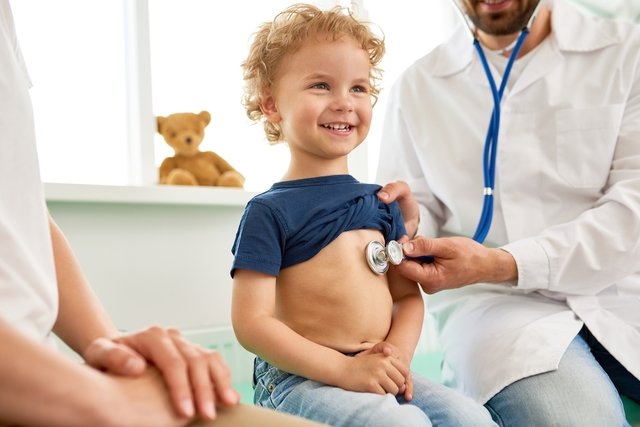The child’s heartbeat considered normal varies according to age, from 100 to 205 bpm, for a newborn baby, to 60 to 100 bpm, for a 13-year-old teenager awake and at rest.
Although changes in heart rate can be seen in common situations, such as when the child sleeps, cries or is playing, in some cases they can be caused by pain, fever, dehydration or more serious conditions, such as arrhythmias or shortness of breath, for example.
In case of changes in heartbeat, especially if other symptoms appear, it is recommended to consult a pediatrician. However, if these symptoms are severe, such as shortness of breath or drowsiness, it is recommended to go to an emergency room for an evaluation.

Table of normal heart rate in children
The table below indicates normal heart rate variations by age in beats per minute (bpm) for a child awake and during sleep:
You can check the heartbeat easily by placing a device called an oximeter on the baby’s or child’s finger after a period of at least 5 minutes of rest. However, to check correctly and carry out a more detailed assessment, the ideal is to consult a pediatrician. Find out more details on how to measure your heartbeat.
If you want to make an appointment, find a pediatrician closest to you using the tool below:
Taking care of your health has never been easier!
Make an appointment with our Pediatricians and receive the personalized care you deserve.
Changes in heart rate in children
The heart rate of babies and children can increase or decrease in different situations, such as during sleep in case of fever.
What increases heart rate
Increased heart rate in babies and children is usually caused by fever, fear, pain, agitation or crying, but in some cases it can also be caused by more serious situations, such as lack of oxygen, dehydration, anemia or arrhythmias.
The heart rate is considered to be increased (tachycardia) when the heart rate is above the normal limit for the child’s age.
Read too: Tachycardia: what it is, symptoms, causes and treatment
What slows down the heart rate
Decreased heart rate in babies and children usually occurs during sleep or rest, but can also be caused by arrhythmias, hypothyroidism, severe shortness of breath or increased intracranial pressure, for example.
The heartbeat is considered slow (bradycardia) when the heart rate is below the normal limit for the child’s age. Understand better what bradycardia is and its causes.
What to do when your heartbeat is altered
Some measures can help normalize the child’s heartbeat, such as:
- Treat fever with baths and antipyretics, as advised by your doctor;
- Avoid dehydration by drinking fluids;
- Use homemade serum or oral rehydration serum in case of vomiting or diarrhea;
- Treat the asthma attack with bronchodilators, as recommended by your doctor.
However, when heartbeat changes are accompanied by symptoms such as fever, diarrhea, vomiting or coughing, it is important to consult a pediatrician as soon as possible so that the cause can be identified and the most appropriate treatment can be started.
Furthermore, if symptoms such as fainting, drowsiness, paleness, tiredness, decreased urine output or changes in the skin occur, such as a bluish or marble-like appearance, it is important to seek an emergency room for an evaluation.
Bibliography
- STATPEARLS. Vital Sign Assessment. 2023. Available at: <https://www.ncbi.nlm.nih.gov/books/NBK553213/>. Accessed on April 30, 2024
- AEHLERT, Barbara et al. PALS: Pediatric Advanced Life Support Study Guide. 4.ed. Burlington, MA: Jones & Bartlett Learning, 2018.
- FLEMING, Susannah et al. Normal ranges of heart rate and respiratory rate in children from birth to 18 years of age: a systematic review of observational studies. The Lancet Journal. Vol.377, n.9770. 1011-1018, 2011
- MICK, Nathan W; WILLIAMS, Rachel J. Pediatric Cardiac Arrest Resuscitation. Emerg Med Clin North Am. Vol.38, n.4. 819-839, 2020

Sign up for our newsletter and stay up to date with exclusive news
that can transform your routine!
Warning: Undefined array key "title" in /home/storelat/public_html/wp-content/plugins/link-whisper-premium/templates/frontend/related-posts.php on line 12
Warning: Undefined array key "title_tag" in /home/storelat/public_html/wp-content/plugins/link-whisper-premium/templates/frontend/related-posts.php on line 13



